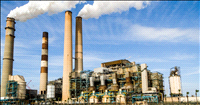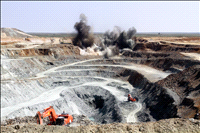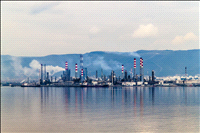Uncertainties grip the global economy
26 Aug 2008
Which is the worst performing large economy at this moment? Going by the level of whining in the media, it has to be the US. Popular perception is that the US economy is either already in a recession or is all set to slip into one, depending on how pessimistic the respondents are. And, the level of pessimism about the economy among Americans depends on whether they have actually lost their jobs and homes, or they are only about to lose either or both.
But, hard data often contradicts popular perceptions.
Of the seven largest OECD economies, four actually contracted and one came to a standstill during the second quarter of this year. Of the remaining two, the UK registered a modest expansion and the Bank of England says the country's economy is likely to stagnate for the foreseeable future. And, weathering all the storms, the best performer in this group was the US!
For the April-June quarter, the Euro area economy as a whole shrank 0.8 per cent on an annualised basis. In contrast, the American economy actually expanded at a very healthy 1.9 per cent for the same period, given the heavy pounding it is facing. This is the first time the Euro zone GDP is contracting on a quarter-on-quarter basis since it started tracking the data in 1995. The Japanese economy also contracted during this period, belying hopes of a sustained recovery after the prolonged slump since the early '90s.
Then there are the emerging economies, which continued to fly high when the rest of the world came under a cloud. The commodity price correction has spread a pall of gloom over Russia and Brazil, as both countries are highly dependent on resource exports. Even though commodity prices are still higher than last year's levels, the rate of growth will slow down in both Brazil and Russia.
In India, we are now pretty convinced about the deceleration. With inflation continuing to inch up and more rate hikes expected, GDP growth may slip further this year, the next and maybe even beyond. The most optimistic forecast for current year growth, excluding the absurdly high CMIE figure, barely touches the 8 per cent mark. If inflation rises further, the actual growth figure may decline closer to 7 per cent.
That leaves China, the last big hope and the only major economy that is yet to report any significant slowdown in growth momentum. But, with the Olympics nearly over, the Chinese government is now shifting its attention back to the economy.
Though inflation has cooled down in recent months, prices still remain high and may invite more interest rate hikes. As the rest of the world has clearely slowed down, Chinese export growth may decline. It is also possible that Chinese exporters may see an increase in demand for low-priced goods as global consumers shift down to cheaper products, a trend that is now benefiting US discount retailers at the cost of more upmarket retail stores.
There is speculation about a possible economic stimulus package, which led to the Shanghai index jumping more than 7 per cent. Does the Chinese government anticipate a deceleration in the near future? Why else would it consider a stimulus package?
The Asian Development Bank says Chinese growth will cool to 9.9 per cent this year and 9.7 per cent the next.
So, where is the world economy headed for in the near term?
The credit crisis is far from over
The global credit crisis that started around this time last year has flared up again. Until last month, it seemed as if the worst was behind us. The interest rate cuts and the massive infusion of liquidity into the markets by central banks appeared to have calmed their fears of a liquidity squeeze. Confidence seemed to be gradually returning and credit availability was expected to ease in the coming months, giving the much-needed liquidity boost to growth.
Those hopes have evaporated in no time and many fear that the credit turmoil that may hit the world over the next year could be far worse than what we saw last year. In fact, the credit crisis may be nowhere near to the beginning of its end.
When global banks were furiously writing down the assets in their books to the extent of tens of billions of dollars, the expectation was that there would be no more bad assets to worry about. It was believed that all the dead losses had been discarded and the banks would roar back to profitability as their core businesses remained healthy. Such hopes have now been belied.
Far from recovering as hoped, the US housing market continues to slip. Home prices across Europe are tumbling and the correction is now spreading fast across Asia. In the US, mortgage defaults among even prime borrowers are rising. Credit card defaults are rising and corporate credit defaults are expected to increase as margins take a hit. That will mean more losses for the banks, which in turn will rush to raise additional capital to stay afloat and overall credit availability will be squeezed further.
It is evident that fear has now returned to the credit markets. Credit spreads, or the difference between inter-bank lending rates and the official benchmarks, are now close to the levels seen during the worst points of the credit crisis over the last one year. There is only one reason for rising credit spreads - banks have become suspicious of each other's solvency and turned overcautious in lending. And, that is the really bad news.
The threat of inflation
There is not even a single large economy that is not being threatened by rising prices. From the developed world to the emerging economies, every economy of significance is battling inflation. In the 30-member OECD group inflation rose to 4.4 per cent in June, the highest level since 2000.
Within the group, Iceland recorded the highest inflation at 12.8 per cent. Even in Japan, which brought up the tail with annual rate of 2 per cent, inflation is at the highest in many years. Most emerging economies are facing double-digit inflation.
Expectations that the commodity price correction will cool down inflation all over the world may be a bit premature and optimistic. Though prices of essential commodities, especially crude oil, have slipped, they have not yet corrected to any meaningful extent. Lower oil prices will have an impact on consumer inflation in countries where retail fuel prices are market driven.
But for major economies like China and India, oil prices have to fall much lower before any meaningful reduction will be considered in retail fuel prices.
Yes, eventually the decline in overall economic growth will pull down prices. But, the current elevated price levels will prevent central banks from cutting interest rates to support growth. When the world last faced a significant slowdown after 2001, major central banks could rapidly bring down interest rates as inflation was benign.
The US Fed cut interest rates to as low as 1 per cent and even the ECB brought down rates, despite its stiff inflation target. That is not the case now. The US Fed is most likely to keep rates steady until prices cool down and the ECB has little leeway in bringing down rates, which many consider excessively high for a region already in recession.
The longer central banks take to bring down interest rates, the deeper the global slowdown will get. And, more worryingly, the longer will be the road to recovery.
How bad can it get?
The global economy has enjoyed sustained growth in recent years, which is unprecedented in the geographical spread and the pace of growth. Between 2002 and 2007, global growth has averaged close to 5 per cent. Such high growth rates are difficult to sustain over a long period, unless the whole world does a China, and a slowdown is almost certain to follow as the average growth rate reverts to its long-term potential. And, that is what is happening now.
In its most recent report in July, the IMF has upped its global growth forecast to 4.1 per cent for the current year as US growth was unexpectedly high. For the next year, the forecast growth is 3.9 per cent. But, most analysts believe that the IMF is underestimating the true extent of the slowdown and its forecasts are far too optimistic.
Analysts at UBS, for instance, say the world economy will expand by only 3.4 per cent this year and just 2.9 per cent the next. That is perilously close to 2.5 per cent growth, below which UBS considers the global economy to be in a recession.
Those seeking more concrete evidence for the global slowdown need not look further than the Baltic freight index, which tracks shipping rates. Changes in trade volumes are probably the best indicator of global economic growth and shipping rates best reflect the trade trends. From the high of 11,800 in May this year, the index has crashed to 7190 this week.
On balance, the global economy is likely to face a protracted slowdown over the next couple of years. Going by the current trends, a recovery is unlikely before the end of next year.


















.jpg)










